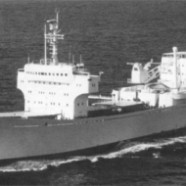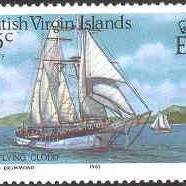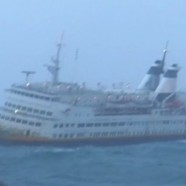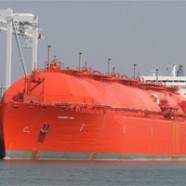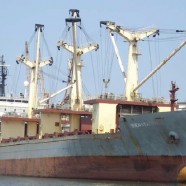Hunting down the Onyx (4)
Prayati Shipping PVT, based in Bombay, owner of the car ferry Onyx, confirms its position as a wrecking ship owner. Asian ship-breaking yards appear to be the only destination of the vessels of its “fleet”.
Identified in the summer of 2009 for having sold the old tanker President to a demolition yard in Bangladesh, only a couple of months after having bought it, Prayati Shipping PVT had also become at the same time the owner of the Rose S, a bulk carrier built in 1976 (see “Hunting down the Onyx, February 4, 2010). Today, the owner just got rid of the Onyx which was detained in ports across the world, and which has not sailed since her purchase: the Rose S has just been beached for demolition in Alang.
Hunting down the Onyx (2)
In a letter addressed to Robin des Bois on February 3rd 2010, the Squadron Vice Admiral, Head of the Maritime Authority in the French Atlantic, subjected the departure of the old car ferry Onyx to weather permitting conditions in order to guarantee the safety of the crew members aboard. It appears as though the weather cleared up at around 10:00 am, the time when the Onyx departed. The letter also mentions that the decision to stop the detention of the Onyx would be taken “under the condition that she was taken to a port for repair”. Brest was therefore only the port of handiworks and fast repair.
Hunting down the Onyx (1)
The Onyx is a car ferry which has 30 years of service in Scandinavia under her belt. She was considered as waste by Finland’s Environmental Authority, but as any waste is considered recoverable according to the doctrine of sustainable development she was bought by an Indian ship owner, Prayati Shipping PVT. This company initially claimed that the ex-Casino Express will be used to transport cars in the Middle East and in a second statement that she will undergo transformations in Turkey with the intention of keeping her in service.
An ex nuclear-powered cargo ship to be demolished in Alang
Without any drumming up, Germany, pioneer in Europe on the application of nuclear energy to power vessels, has let the ex Otto Hahn leave to be manually demolished in Alang bay India. She was launched in 1967 and represents the symbol of failure concerning the first wave of nuclear powered merchant ships. The Otto Hahn was reconverted into a conventional cargo vessel in 1980. The nuclear reactor of 38 MW was removed, yet it is legitimate to suspect that after having been exploited for thirteen years structural elements were exposed to uncontrolled radiation or radioactive releases. In August 1973 the vessel was the victim of a major accident when two fuel elements of the reactor broke.
The End of the last French three-masted ship
After being laid up for several years in Trinidad in the Caribbeans, the ex Oiseau des Iles built by the French shipyard Dubigeon in Nantes in 1935 was sent to be demolished.
The valuable and moving history of this gem of naval construction ranges from the Loire Estuary to the West Indies passing by the South Ocean to French Polynesia and the west coast of Mexico.
The threshold of 1,000 vessels is reached
Global statement 2009 of vessels sent to demolition :
For four years, Robin des Bois has been studying the demolition market via the mobilisation and the analysis of over thirty different bibliographical sources. Robin des Bois counted 293 vessels sold for demolition in 2006, 288 in 2007 and 456 in 2008. In 2009, 1,006 vessels have left the waters, representing more than twice the 2008 total and three times the 2006 total. The total weight of recycled metal reached more than 8.2 million tons, five times the total amount of 2006.
“Shipbreaking” n°17
In February 2009, « because of the restricted visibility due to foggy conditions » the chemical tanker Kashmir loaded with 30.000 t of oil condensates used by the petrochemical industry collided with the container-ship Sima Saman 13 km off Dubaï. The fire which broke out was only brought under control late at night. The plume of smoke darkened the industrial zone and the port of Jebel Ali, south of Dubaï all day long. Five months later the Kashmir was sold for scrapping and towed to India. Soots, residual liquids, melted materials, released asbestos and PCB, dioxins, the working conditions are particularly dangerous for labourers while breaking up damaged ships.
“Shipbreaking” #16
The shame remains but the crime scene has disappeared.
In October 1992, the Renata (then named MC Ruby) was owned by MC Shipping Company, a subsidiary of the Vlassov Group based in Monaco; her ship manager was V Ships, another subsidiary company of the group. The ship was loaded with cocoa in Ghana and was bound for Le Havre, Amsterdam and Hamburg. During the trip, nine stowaways were discovered, stripped of their money and confined in the forepeak ; they were brought up on the deck by night, then struck and thrown on the high seas between Takoradi and Le Havre. The only survivor alerted officials in Le Havre. On December 9th 1995, at the end of a four week trial, the master and the chief-mate were condemned to a life sentence and three other members of the Ukrainian crew to 20 years of detention. Neither the Vlassov group, nor their subsidiary companies (MC Shipping and V. Ships) have been sued, in spite of the degraded conditions imposed on the crew and the many additional traffics on the ship which were highlighted and known to all. The significant bond between the ship management and the crew was not retained. See« Coke en stock », La Flèche, hiver 1996 and « Le désert des Barbares » communiqué de Robin des Bois, 9 décembre 1995.





